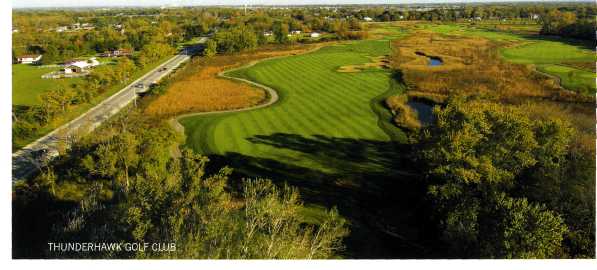 |
Home | Search | Browse | About IPO | Staff | Links |
 |
Home | Search | Browse | About IPO | Staff | Links |
20 I l l i n o i s P a r k s & R e c r e a t i o n www.ILipra.org
www.ILparks.org J u l y / A u g u s t 2008 21 
Making the world a greener place often begins with small steps. For Denise Gillett-Parchert and St. Charles Park District's Pottawatomie Golf Course, something as simple as planting native vegetation can make a big impact on increasing environmental awareness. "We have been able to show the community you can plant native vegetation and it is still attractive. They ask, 'what's this, what's that,' and are surprised they are native. The public has really enjoyed watching them grow," said Gillett-Parchert, the GCSAA Class A superintendent at Pottawatomie. Native plantings, which need fewer inputs because they are designed for their native climate, are just one aspect of the many things golf course superintendents in Illinois do to balance providing great playing conditions with environmental responsibility. Designed with Mother Nature in Mind At the Lake County Forest Preserves' Thunderhawk Golf Club in Beach Park, the environment was part of the focus from the beginning, as architect Robert Trent Jones Jr. designed it with nature in mind. "He designed a golf course that's not difficult to maintain using environmentally friendly practices," said Tom Abbott, the GCSAA Class A superintendent at the club. Thunderhawk opened in 1999 and was the first golf course in Illinois to achieve Audubon Signature certification, a program through Audubon International that helps developers design for the environment so that both economic and environmental objectives are achieved. The environmental objectives continue to be met, including extensive natural prairie areas. Thunderhawk totals 244 acres, with just 90 acres in play for golf. The natural prairie areas make up nearly 50 acres of the property, which is part of the Lake County Forest Preserve District, and provide habitat for deer, coyote and "birds to numerous to count," said Abbott. Providing animal habitat is also a focus at Channahon Park District's Heritage Bluffs Public Golf Club, where Charles Anfield is the GCSAA certified golf course superintendent. The course and Mother Nature both got a boost from habitat restoration the course undertook, thanks to a 1998 grant from the Illinois Department of Natural Resources. Sixteen acres at the course are not part of the regular maintenance plan, including 3 1/2 acres of tallgrass prairie, where last year players on the course witnessed a doe giving birth to her fawn. "That doe felt safe enough to have her baby there. That's what we're trying to do," Anfield said. "That's what my goal is (with these projects), to provide a safe place for plants and animals that don't really have a chance in suburbia." Heritage Bluffs is a Certified Audubon Cooperative Sanctuary and was recognized for its environmental efforts in 2001 with a GCSAA/Go/f Digest Environmental Leaders in Golf Award. Anfield is currently working on a wetland restoration project. Pottawatomie Golf Course's design also makes environmental stewardship simply part of the business plan. Designed in 1939 by Robert Trent Jones Sr., it is a nine-hole neighborhood course located next to the Fox River. This requires no-spray zones along the river, keeping pesticide use on the three holes that border the river to an absolute minimum, and staying as native as possible with plantings. The St. Charles Park District has been highly supportive of Gillett-Parchert's efforts. "When you get support, that just pushes you to try that much harder," Gillett-Parchert said. In 1997, Audubon International gave its support when it named Pottawatomie the first nine-hole course in the world to receive Audubon certification. Green vs. Green While most golf course superintendents make environmental stewardship a key component of their operations, they know their facilities can't survive without providing conditions that keep golfers coming back. So finding middle ground between economics and the environment is often a balancing act that requires understanding from golfers. Located on the outskirts of the Chicago golf market, 75 percent of Heritage Bluffs golfers are non-residents. Anfield says it's the opportunity to really get back to nature that attracts customers to its par-72 layout that features bentgrass tees, fairways and greens. "We've got one foot in cornfields still: it's a natural site with a rural feel," he said. "It gives golfers a chance to get out of the city and have a laid back country experience." 22 I l l i n o i s P a r k s & R e c r e a t i o n www.ILipra.org 
But because so many of their 30,000 rounds a year come from out-of-towners, course conditions have to be maintained to a level where golfers are willing to travel to Heritage Bluffs. Luckily, the general public's greater awareness of environmental issues over the last few years goes a long way in convincing golfers that prairie areas aren't just weeds; and, just because the course in the country, golfers and the community can't take nature for granted. Anfield says his strategy for balancing the green of dollars with a greener planet is a little like living a healthy lifestyle. "I really think we have found that moderation is the key," he said. "Our focus is on preventative maintenance. A preventative maintenance program is just like good health. It costs more to fight a pest than it does to try to prevent it, just as it costs more to go to the doctor than it does to eat right and exercise." And when a facility balances its financial goals and environmental stewardship, it can be a win-win for all. When the Fox River began eroding the golf holes along its banks at Pottawatomie, Gillett-Parchert and her staff began a restoration project that included planting native flora along the banks and using gabion baskets, which not only stabilize the soil, but also filter runoff, preventing it from reaching the river water. "Not only did we stop the erosion, but we helped the environment," she said. On top of that, the St. Charles Park District won the 2007 IPRA Outstanding Facility and Parks Award for Division IV/Renovation, partly because of this effort. "We do everything we can do to make the experience for the golfer more enjoyable, but our efforts are also designed to help in other ways, too. It really is a whole package," Gillett-Parchert said. Getting the Word Out Letting golfers and the community know what environmental efforts go on at golf courses makes them part of the green process, and it makes it easier for park, recreation and conservation agencies to make choices with the environment in mind. Gillett-Parchert said she is fortunate to have a dedicated following of golfers at her course who treat the public course almost as if it were their own private club. So, finding support for environmental efforts and knowing where the golfers stand on the issue is fairly simple at Pottawatomie. "They are quite engaged. We don't do anything without their input. It's a blessing that they care about the course so much," Gillett-Parchert said. "When people appreciate what you are doing, it makes your job so much easier." For Anfield at Heritage Bluffs, communicating with a large number of golfers who live outside of the park district can be a challenge. He tries to keep golfers informed about environmental efforts by maintaining a display in the clubhouse and posting articles about upcoming efforts or issues affecting the course, such as problems with the Emerald Ash Borer, an invasive species of beetle that threatens ash trees. "You've got to have a receptive audience and people who want to (focus on the environment)," he said. At Thunderhawk, Abbot works with the Lake County Forest Preserves' natural resources technician on a variety of projects, and happenings at the course are chronicled in the forest preserves' quarterly newsletter, which has 25,000 people on its mailing list. From best maintenance practices to communicating environmental efforts, golf course superintendents in the state are working to make the golf courses of Illinois friendly to both the economy and the environment. Angela Nitz is the manager of corporate communications for the Golf Course Superintendents Association of America. Since 1926, GCSAA has been the top professional association for the men and women who manage golf courses in the United States and worldwide. From its headquarters in Lawrence, Kansas, the association provides education, information and representation to more than 21,000 members in more than 72 countries. GCSAA's mission is to serve its members, advance their profession and enhance the enjoyment, growth and vitality of the game. The association's philanthropic organization, the Environmental Institute for Golf, works to strengthen the compatibility of golf with the natural environment through research grants, support for education programs and outreach efforts. Visit GCSAA at www.gcsaa.org. www.ILparks.org J u l y / A u g u s t 2008 23 |Home|
|Search|
|Back to Periodicals Available|
|Table of Contents|
|Back to Illinois Parks & Recreation 2008|
|